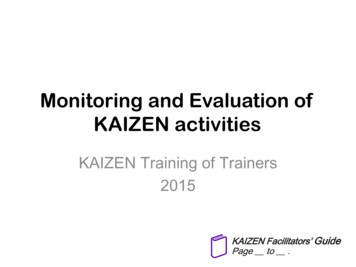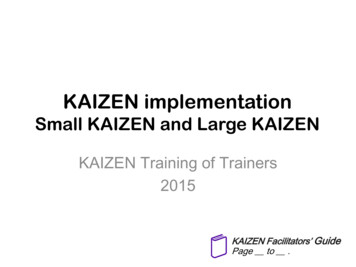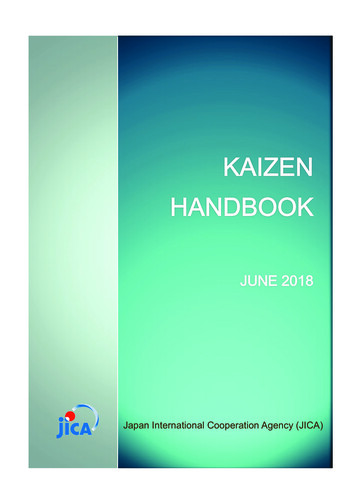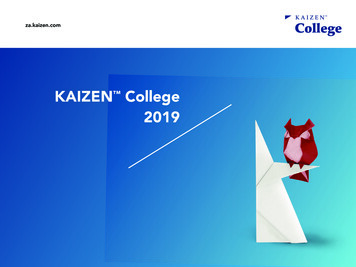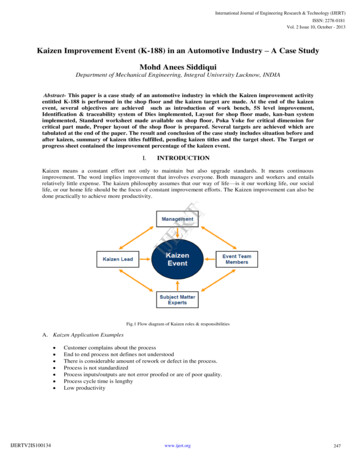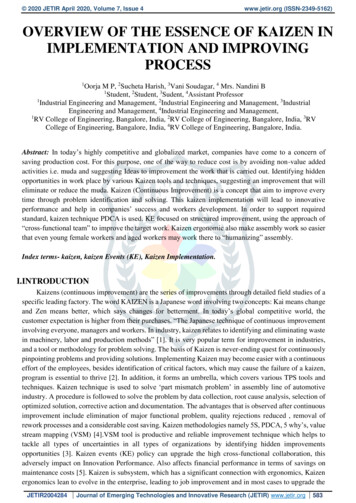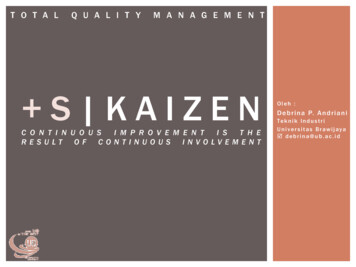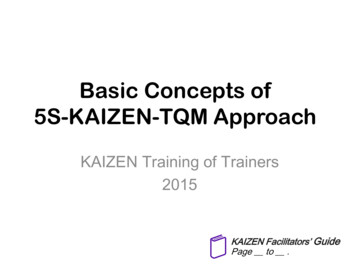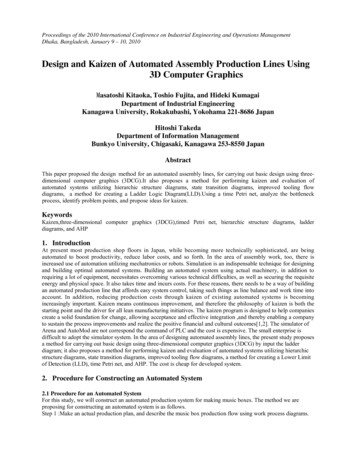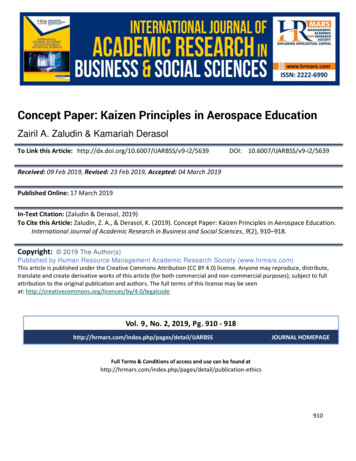
Transcription
International Journal of Academic Research in Business and Social SciencesVol. 9 , No. 2, Feb, 2019, E-ISSN: 2 22 2 -6990 2019 HRMARSConcept Paper: Kaizen Principles in Aerospace EducationZairil A. Zaludin & Kamariah DerasolTo Link this Article: http://dx.doi.org/10.6007/IJARBSS/v9-i2/5639DOI: 10.6007/IJARBSS/v9-i2/5639Received: 09 Feb 2019, Revised: 23 Feb 2019, Accepted: 04 March 2019Published Online: 17 March 2019In-Text Citation: (Zaludin & Derasol, 2019)To Cite this Article: Zaludin, Z. A., & Derasol, K. (2019). Concept Paper: Kaizen Principles in Aerospace Education.International Journal of Academic Research in Business and Social Sciences, 9(2), 910–918.Copyright: 2019 The Author(s)Published by Human Resource Management Academic Research Society (www.hrmars.com)This article is published under the Creative Commons Attribution (CC BY 4.0) license. Anyone may reproduce, distribute,translate and create derivative works of this article (for both commercial and non-commercial purposes), subject to fullattribution to the original publication and authors. The full terms of this license may be seenat: deVol. 9, No. 2, 2019, Pg. 910 - SJOURNAL HOMEPAGEFull Terms & Conditions of access and use can be found tion-ethics910
International Journal of Academic Research in Business and Social SciencesVol. 9 , No. 2, Feb, 2019, E-ISSN: 2 22 2 -6990 2019 HRMARSConcept Paper: Kaizen Principles in AerospaceEducationZairil A. ZaludinDepartment of Aerospace, Faculty of Engineering, Universiti Putra Malaysia, Serdang, Selangor,MalaysiaKamariah DerasolCounseling Division, Universiti Putra Malaysia, Serdang, Selangor, MalaysiaAbstractEducating students in Aerospace Engineering courses requires expensive equipment and highlytrained professionals. A lot of the equipment and personnel are also used by the same aerospaceindustry to test and manufacture aerospace vehicles. This is a normal practice in establishedinternational universities such as those in the UK and the USA. The positive side of such practice isthat it ensures that the graduates are 'industry-ready' by the time they graduate. But as time goesby, the cost of purchasing and maintaining the equipment and professionals become extremelyexpensive. Unlike profit making aerospace industry, Malaysian universities offering these courses arenot aggressive by nature to generate their own income to sustain the use of the equipment andpersonnel. In most cases, universities struggle to maintain the equipment after purchase, and overtime students’ education are affected resulting in a terrible lost in education quality and universityintegrity. KAIZEN principles would be a good model to use to assist in breaking such 'pattern'. In thispaper a small-scale test has been conducted using one of the most challenging course subjectsoffered to Aerospace students. The flight-testing laboratory course is part of the 4-year Bachelor inAerospace Engineering course in UPM. The EAS 3924 Aviation Laboratory for Agriculture Applicationwas used to demonstrate how KAIZEN principles have helped produced great results and played apivotal role to break a deadlock and helped to keep the standard of aerospace education high aspromised to students. The laboratory required the use of an aircraft to fly safely but the appropriateequipment was not available to students due to cost and aircraft availability. Using KAIZEN principles,it was not only feasible to run the laboratory successfully but the entire Aerospace Engineering coursecould now be run leaner and efficiently with the potential to supersede the course and programobjectives manifold. It is possible to make aerospace engineering students receive quality aerospaceengineering education whilst the university keep the cost of operation down and in the case of EAS3924, that cost was virtually zero.911
International Journal of Academic Research in Business and Social SciencesVol. 9 , No. 2, Feb, 2019, E-ISSN: 2 22 2 -6990 2019 HRMARSKeywords:Aerospace Education, Flight Testing, Flying Laboratory, Kaizen Aerospace, Aviation LabINTRODUCTIONKaizen principles are commonly understood to carry the meaning “continuous improvement”. Onewould agree that the principles are encouraging society to 'grow' from where they are after they starttheir journey to accomplish some goals. Regardless of the state they are in as the journey continues,they are encouraged to face the inevitable problems objectively and solve those problems creatively,and proceed to grow and aim to continue to improve even further after that. This eliminates thewasteful exercise of giving up, or blaming one another for mistakes, which will only cause more waste,and not necessarily solve the main problems in the end. Such mature 'attitude' to move on andprosper in manufacturing is crucially important for obvious reasons and has been demonstratedmany times to produce positive improvements in every sense of the word. In Aerospace industry, thishas been documented well in Ref (1), (2) and (3). Aerospace industry is one of the most aggressiveand lucrative, coated with many rules, regulations and standards in an effort to create very small, ifnot, zero margin for error. Such is the nature of the industry which builds extremely reliable aircraft,missiles, satellites and rockets that costs billions of dollars. KAIZEN principles have been shown tohelp Aerospace industry prosper. If Kaizen has been used to help the industry, the same philosophyshould also be implemented in Aerospace education, in an effort to produce similar sort of qualityproducts and service. The application of KAIZEN principles in institution of higher learning has beendocumented and studied as documented in Ref (4), (5) and (6). But such work in Aerospace educationin universities has not yet been seen. This paper illustrates what happened if such principles areadopted well in an Aerospace education. The results showed that not only the institution of higherlearning got out of an unsolvable problem, the cost of the solution was extremely lean. In fact, manypositive outcomes came out from the results of KAIZEN solutions that new relationships, projects,and collaborations has happened since the success of the project. This fresh positive energy hasbenefited the staff and students. This is optimization we didn't previously expect nor anticipated.PURPOSE AND PROBLEM STATEMENTEAS 3924 Aviation Laboratory for Agriculture Application was a compulsory laboratory for the 4thyear students in the UPM undergraduate Bachelor of Aerospace Engineering program. In essence,the course aimed to be similar to that offered by Cranfield University in the UK. In CranfieldUniversity, a Jetstream 31 aircraft was used which had been fitted with additional sensors andinstrumentation for their flight testing courses. In UPM, the aircraft purchased by the university wasa Cirrus SR20, a low-wing light sports aircraft with a registered tail number 9M-KAA [Figure 1]. By2016, it was discovered that a few batches of students had completely stopped flying because theaircraft had been grounded for some time due to heavy financial problems and suffering from a listof technical issues.912
International Journal of Academic Research in Business and Social SciencesVol. 9 , No. 2, Feb, 2019, E-ISSN: 2 22 2 -6990 2019 HRMARSFIGURE 1: 9M-KAAAn immediate solution as replacement to this problem was to use the purchased Flight Simulatorequipment. It was also discovered in 2016 that the flight simulator was neither operational norcommissioned completely during delivery as shown in Figure 2. It was a bad blow to the students(paid customers) who had looked forward to such adventure in their Aerospace education, most ofwhom had waited 4 years for it, with no such promise delivered in the end.913
International Journal of Academic Research in Business and Social SciencesVol. 9 , No. 2, Feb, 2019, E-ISSN: 2 22 2 -6990 2019 HRMARSFIGURE 2: Unusual Flight SimulatorThe purpose of this paper is to propose a solution that breaks a deadlock when faced with a situationlike this due to the high cost of operating aerospace equipment and the fees associated to hiringqualified professionals to operate them during teaching Aerospace Engineering Degree program,without compromising quality or integrity. The test subject chosen to test the effectiveness ofimplementing KAIZEN principles was therefore, this course subject EAS 3924. The study looked intothe effectiveness of implementing fundamental KAIZEN principles to break the deadlock and prosper.PROJECT DESCRIPTIONUsing fundamental KAIZEN principles, the aim of this project was to solve the problem of running anAerospace Engineering Degree program when faced with a challenge of escalating cost of equipmentand personnel without compromising university integrity and possibly improve Aerospace Educationholistically. Since the subject EAS 3924 had this problem, it was a perfect candidate to be used as testsubject. The project had 3 objectives:1) Allow all students to experience the process of flight testing in a proper flight testingenvironment with the right personnel and facilities as per or beyond the EAS 3924 subject914
International Journal of Academic Research in Business and Social SciencesVol. 9 , No. 2, Feb, 2019, E-ISSN: 2 22 2 -6990 2019 HRMARSsyllabus as well as per mandatory Bachelor of Aerospace Engineering course accreditationrequirement.2) Students must experience flight, motion of aircraft during flight testing, able to record air dataduring flight testing and able to analyze those data on the ground as per course requirement.3) Students must be able to present their findings after the flight testing was complete in thesame manner as how actual Flight Test Engineers in an established aerospace company wouldpresent, to demonstrate their competency to do the job properly.The project was also interested to observe if any other positive benefits could be achieved beyondthese objectives that might benefit the society and community as a whole.METHODOLOGYThe problem was detected in 2016. In 2017 effort began to take shape to create the best possiblesolution to allow flight testing course to be conducted properly for the students in the Departmentof Aerospace, UPM. The 2 most fundamental Kaizen principles were used: 1) ContinuousImprovement and 2) Eliminate Waste.The main problem was the in-availability of airworthy 9M-KAA Cirrus SR20 UPM aircraft for studentsto use. The aircraft also had to have certified pilot and ground crew before it could fly safely whichthe university also did not have. The cost to make the aircraft airworthy and hire the crew was toohigh.In the spirit of “continuous improvement”, the obvious first solution was to find a suitable airworthyaircraft and certified pilots and ground crew to operate them. With no budget allocated for thisactivity, the second principle of KAIZEN was used - which was to keep it LEAN and eliminate waste. Itwas a perfect opportunity to use ‘creativity’ on how to still complete this goal without purchasing anew aircraft (and create even more waste) or money to hire professionals to operate the machine.Using only integrity and wits, these objectives must be accomplished.There was abundance of support from both local and international aerospace industry if one knewhow to ask. As the staff of the Aerospace course should have significant Aerospace background andshould be associated with the Aerospace industry, it was only natural for members of staff to seekassistance from each other including from the industry ‘in a human way’. ‘Humanizing’ was also theKAIZEN way. Even in Aerospace Education ‘humanizing’ was clearly valid and as shown later, provento work so well. The solution to the EAS 3924 problem was found by simply asking a local flying club,the Air Adventure Flying Club which was based in Subang Airport, to assist and support theDepartment of Aerospace UPM in delivering the flight testing portion of the EAS 3924 course subject.All it took, was ‘ask’. The benefit of using the flying club facilities and personnel was obvious. Theyhad 3 airworthy aircraft (Cessna 172), they operated the aircraft on daily basis and they already hadcertified pilots and ground crews working every day. It was what they did every day - something aninstitution of higher learning could not do well due to lack of experience, budget and professionalcrew, not to mention beyond their scope of business.915
International Journal of Academic Research in Business and Social SciencesVol. 9 , No. 2, Feb, 2019, E-ISSN: 2 22 2 -6990 2019 HRMARSIt is important to mention that although the flight testing was conducted by the flying club, the courselecturer in UPM was still driving the lessons. Using the syllabus as guide, the lecturer only had to ‘lead’both the flying club and the students what to do to accomplish the course objectives successfully. Aproperly trained aerospace lecturer should find the management of the flight testing course easy asthe course should have been in their training too at some point in their aerospace education life.RESULTSBy simply applying the 2 fundamental Kaizen principles, the costly problems of running the EAS 3924course subject was solved. Students essentially completed the course subject successfully and otherpositive outcomes resulted too. Shown next are other successful accomplishments that came outfrom this exercise:1) Free membership for all participating students in 2017 worth RM180,000.00 from Air AdventureFlying Club. This membership allowed the Aerospace students to enter the club’s hangar and interactwith other facilities in Subang Airport.2) Full access to 3, Cessna 172 light aircraft, owned by the Air Adventure Flying Club for all Aerospacestudents. Other light aircraft, private jets and aerobatic planes belonging to other owners, companiesand organizations in Subang Airport were also available for students to interact with because the AirAdventure Flying Club knew all of them and introduced the students to them (instant networkingwith real aviators and aerospace companies).3) All students received comprehensive briefing and lessons from pilots and ground crew in the AirAdventure Flying Club. Students were brought together in small groups to interact with the club’saviators, planes, cockpits, aircraft engine and so on. Students were however, constantly reminded tofocus on flight testing an aircraft as the course subject but these interactions were equally importantfor flight testing purposes.4) Aerospace students received access to the Department of Meteorology, Selangor in Subang Airportand comprehensive briefing by their professional personnel. The students were shown how weathermeasuring instruments were used, some of which were rarely seen by the public. The resultsproduced by the equipment were used to create weather reports and prediction which weretransmitted in real-time to pilots world-wide.5) Aerospace students also saw a demonstration and briefing by the Airport Fire and Rescue Services(AFRS) under the Malaysian Airport Berhad (MAB) on handling emergencies in airports especiallyduring flight testing. The Fire Services crew demonstrated the use of their fire engine in the event ofmajor accident during flight testing.6) Aerospace students had a special access to visit the Air Traffic Control (ATC) Tower in SubangAirport where air traffic controllers showed how they controlled Subang Airport airspace and groundmovements at all times including during flight testing.916
International Journal of Academic Research in Business and Social SciencesVol. 9 , No. 2, Feb, 2019, E-ISSN: 2 22 2 -6990 2019 HRMARS7) Air Adventure Flying Club sponsored 1 flight for 3 lucky Aerospace students. They had to performaerial flight testing using similar flight test instructions used to test aircraft such as the Airbus A380and Boeing 777. Other students who did not fly acted as ground flight test engineers supporting the3 students at all times. This was the same arrangement in the Aerospace industry.8) ‘The Star’, a mainstream Malaysian daily newspaper, learned about this collaboration effortbetween the Department of Aerospace, UPM and the Air Adventure Flying Club and published a 3page Cover-Story article in the newspaper [7].FUTURE POTENTIALS IN APPLYING KAIZEN IN AEROSPACE EDUCATIONMany other similar cost cutting exercises could be done for other laboratories and lectures in theaerospace education simply by working together closely with the current aerospace industry. Thishas the positive benefit to narrow down the gap even more between the aerospace education sectorand the aerospace industry. ‘Humanizing’ healthy aerospace co-operation between academia andcompanies, for the benefit of producing quality aerospace students, should be a culture in MalaysianAerospace ecosystem. Using KAIZEN principles as guide, this vision may be possible to achieve in thequickest time.CONCLUSIONSThe work documented here has shown how using KAIZEN fundamental principles have helped tobreak the deadlock for one of the most popular aerospace course subject in the Bachelor ofAerospace Engineering course. Simply practicing the attitude of ‘continuous improvement’ and‘eliminate waste’, by being honest and transparent about the problem, and genuinely sincere to findthe best solution to the problem and move on, the Aerospace students received their educationsatisfactorily, amazing professional relationships were established and the university integrityremained intact.REFERENCESHaque, B. (2003). Lean Engineering in the Aerospace Industry, Proceedings of Institute of MechanicalEngineers, Part B: Journal of Engineering Manufacture, 217(10), 1409 - 1420.Forman, C. R., & Vargas, D.H. (1999). Affecting the value chain through supplier kaizen, HospitalMateriel Management Quarterly, 20(3), 21-27.Mathaisel, D. F. X. (2005). A lean architecture for transforming the aerospace maintenance, repairand overhaul (MRO) enterprise, International Journal of Productivity and PerformanceManagement, 54(8), 623–644.Kregel, I. (2017). Applying Kaizen to University Teaching Through Weekly Course Evaluation, 4thInternational Conference On Lean Six Sigma for Higher Education, Purdue University, 25-26 May2017. Edinburgh, UK: Heriot-Watt University School of Social Sciences.Emiliani, M.L. (2005). Using Kaizen to Improve Graduate Business School Degree Programs, QualityAssurance in Education, 13(1), 37 - 52.Awi, A. (2016). The Effect of Lean Kaizen Application on Student’s Satisfaction in Malaysian HigherEducation Sector (Doctoral dissertation). Retrieved from917
International Journal of Academic Research in Business and Social SciencesVol. 9 , No. 2, Feb, 2019, E-ISSN: 2 22 2 -6990 2019 shah%20Awi%20%284651170%29 Redacted.pdfMenon, S. (2017, Dec 17). More to Designing Plane - Putting Knowledge into Practice, The StarNewspaper (Star Educate Section), p. 1, 6, 7.918
KAIZEN way. Even in Aerospace Education 'humanizing' was clearly valid and as shown later, proven to work so well. The solution to the EAS 3924 problem was found by simply asking a local flying club, the Air Adventure Flying Club which was based in Subang Airport, to assist and support the Department of Aerospace UPM in delivering the .
